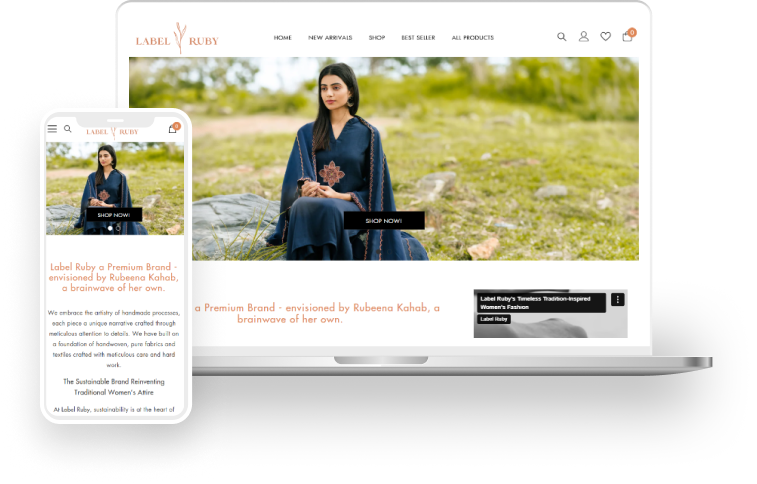LABEL RUBY
Label Ruby is not just another fashion brand – it is Rubeena Kahab’s vision that has been brought to life. These clothes tell stories. When you run your fingers along the handloom cotton or the delicate embroidery, you’re touching centuries of Indian craft that refused to disappear. It is the luxury that does not keep you up at night – where beautiful things last longer than a season, and the person who made them was paid fairly. That is the real magic: what you wear respects the artisan and the earth. Our atelier hummed with creativity – hands stitching, fabrics flowing, stories taking shape. We are weaving that same energy into every click, scroll, and discovery online.
Eager to Use our Service?
Let’s discuss your ideas and see what our team can do for you.

Challenges
We grappled with coordinating intricate production workflows across weavers, embroiderers, and tailors operating as a handmade label. This helped us to collaborate with artisans nationwide. Our pledge to ethical transparency demanded precise records of sustainable materials and artisan techniques, but disjointed tools hindered consistent tracking. Rising requests for personalized adjustments – from hem lengths to fabric swapsal – exposed our platform’s inability to handle bespoke orders gracefully. Above all, while we guaranteed fair wages to every artisan, our existing systems lacked clarity in calculating and showcasing their earnings per purchase, leaving artisans and customers seeking greater visibility.
TECHNOLOGIES WE USED
- Shopify
- JavaScript
- jQuery
- HTML5
- CSS3
- Facebook Pixel
- Shopify Payments
- Visa
- Mastercard
- Maestro
- American Express
- Apple Pay
- WhatsApp Integration
- SSL Certificate
Our Approach
Customizing Shopify for Handmade Workflows
Shopify works well for standard e-commerce but was not equipped to manage our unique needs around artisan production tracking and custom-tailoring. To adapt it, we used metafield editors to directly record artisan IDs, material certifications, and production stages on product pages. We also built a custom order notes API to capture detailed requests at checkout, such as sleeve length adjustments or fabric substitutions. We transformed Shopify’s vendor account system into a supplier portal with commission dashboards personalized for each artisan to support our network of makers.
Sustainable UX Alignment
Our commitment to sustainability also shaped the way we built the user experience. We implemented localized caching to reduce repeat server calls. This helped us with speed and energy usage. Recognizing that many of our customers and artisans live in rural areas with limited connectivity, we introduced a low-bandwidth mode that simplifies the site’s layout using lightweight CSS. To build trust and transparency, we automated the display of ethical scores by directly pulling Good On You ratings into the shopping experience using Shopify Scripts.
Performance Optimization
As we integrated apps like Loox, Klarna, and EcoCart, we noticed a dip in performance that risked disrupting the user experience. To tackle this, we enabled conditional loading so that review widgets only appear when users scroll to specific sections. Our product images were optimized in WebP format and served via Shopify’s global content delivery network to reduce load times. Additionally, we streamlined analytics by consolidating all tracking pixels, such as Facebook and Google, under Google Tag Manager. This allowed us to implement the script at the rate of knots.
Our Solution
Shopify Payments API integration with artisan commission auto-distribution.Payment API integration which accepts multiple currencies.
Integrated Loox Reviews to build trust through customer photos and stories.
Implemented PCI Compliance and SSL certification for secure ethical transactions.
Language localization for IN/UK/US markets with regional sizing charts.

 Blazor
Blazor
 Angular
Angular
 ASP.NET Core
ASP.NET Core
 NodeJS
NodeJS
 React Native
React Native




 60+
60+